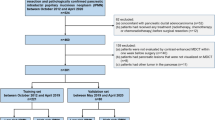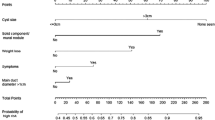Abstract
Background
The objective of the present study was to use clinical and laboratory data to develop a model for predicting the presence of carcinoma in patients with intraductal papillary mucinous neoplasm (IPMN).
Methods
Data were collected on 81 patients with IPMN who underwent a pancreatic resection between 1989 and 2008 at Aichi Cancer Center Hospital. Variables analyzed included age, gender, laboratory findings (serum amylase, carcinoembryonic antigen, and carbohydrate antigen 19-9 level), pancreatic juice cytology grade, and imaging studies. Factors associated with the presence of carcinoma were evaluated by univariate and multivariate logistic regression analysis.
Results
Among the 81 patients with IPMN, 34 (42%) had malignant tumors (noninvasive carcinoma in 22 and invasive carcinoma in 12), and 47 (58%) had adenoma. On multivariate analysis, existing carcinoma was associated with female gender, main pancreatic duct IPMN, nodule size, and pancreatic juice cytology grade. Based on these variables, a predictive nomogram was developed. The area under the receiver operating characteristic curve (AUC) for the model was 0.903. The sensitivity and specificity of the model were 97.1 and 68.1%, respectively, in the validation study, for which the predictive probability of >10% was used to indicate the presence of carcinoma.
Conclusions
The nomogram has high diagnostic predictability for carcinoma in patients with IPMN and for individual cancer probability. This instrument may help to identify patients who need a surgical procedure.


Similar content being viewed by others
References
Ohashi K, Murakami Y, Maruyama M et al (1982) Four cases of mucous secreting pancreatic cancer. Prog Diag Endosc 20:348–351
Kloppel G, Solcia E, Longnecker DS et al (1996) World Health Organization international histological typing of tumors of the exocrine pancreas. Springer, Berlin, pp 1–61
Longnecker DS, Adler G, Hruban RH et al (2000) Intraductal papillary-mucinous neoplasms of the pancreas. In: Hamilton SR, Aaltonen LA (eds) World Health Organization classification of tumors. Pathology and genetics of tumors of the digestive system. IARC Press, Lyon, pp 237–241
Tanaka M, Kobayashi K, Mizumoto K et al (2005) Clinical aspects of intraductal papillary mucinous neoplasm of the pancreas. J Gastroenterol 40:669–675
Kim SC, Park KT, Lee YJ et al (2008) Intraductal papillary mucinous neoplasm of the pancreas: clinical characteristics and treatment outcomes of 118 consecutive patients from a single center. J Hepatobiliary Pancreat Surg 15:183–188
Doi R, Fujimoto K, Wada M et al (2002) Surgical management of intraductal papillary mucinous tumor of the pancreas. Surgery 132:80–85
Sohn TA, Yeo CJ, Cameron JL et al (2004) Intraductal papillary mucinous neoplasms of the pancreas: an updated experience. Ann Surg 239:788–797 (discussion 797–799)
Wada K, Kozarek RA, Traverso LW (2005) Outcomes following resection of invasive and noninvasive intraductal papillary mucinous neoplasms of the pancreas. Am J Surg 189:632–636 (discussion 637)
Yamaguchi K, Nakamura M, Shirahane K et al (2005) Pancreatic juice cytology in IPMN of the pancreas. Pancreatology 5:416–421 (discussion 421)
Hanley JA, McNeil BJ (1982) The meaning and use of the area under a receiver operating characteristic (ROC) curve. Radiology 143:29–36
Harrell FE Jr, Califf RM, Pryor DB et al (1982) Evaluating the yield of medical tests. JAMA 247:2543–2546
Tanaka M, Chari S, Adsay V et al (2006) International consensus guidelines for management of intraductal papillary mucinous neoplasms and mucinous cystic neoplasms of the pancreas. Pancreatology 6:17–32
Harrell FE (2001) Regression modeling strategies: with applications to linear models, logistic regression, and survival analysis. Springer-Verlag, New York
Furukawa T, Takahashi T, Kobari M et al (1992) The mucus-hypersecreting tumor of the pancreas. Development and extension visualized by three-dimensional computerized mapping. Cancer 70:1505–1513
Yamaguchi K, Chijiwa K, Shimizu S et al (1998) Comparison of endoscopic retrograde and magnetic resonance cholangiopancreatography in the surgical diagnosis of pancreatic diseases. Am J Surg 175:203–208
Koito K, Namieno T, Ichimura T et al (1998) Mucin-producing pancreatic tumors: comparison of MR cholangiopancreatography with endoscopic retrograde cholangiopancreatography. Radiology 208:231–237
Procacci C, Carbognin G, Accordini S et al (2001) CT features of malignant mucinous cystic tumors of the pancreas. Eur Radiol 11:1626–1630
Kobayashi G, Fujita N, Lee S et al (1990) Correlation between ultrasonographic findings and pathological diagnosis of mucin producing tumor of the pancreas. Nippon Shokakibyo Gakkai Zasshi 87:235–242
Fujimoto M, Nakazawa S, Yamao K et al (1994) Diagnostic strategy for malignancy and parenchymal invasion of so-called mucin-producing tumor of the pancreas. Nippon Shokakibyo Gakkai Zasshi 91:2073–2082
Yamao K, Nakamura T, Suzuki T et al (2003) Endoscopic diagnosis and staging of mucinous cystic neoplasms and intraductal papillary-mucinous tumors. J Hepatobiliary Pancreat Surg 10:142–146
Uehara H, Nakaizumi A, Tatsuta M et al (1997) Diagnosis of carcinoma in situ of the pancreas by peroral pancreatoscopy and pancreatoscopic cytology. Cancer 79:454–461
Hara T, Yamaguchi T, Ishihara T et al (2002) Diagnosis and patient management of intraductal papillary-mucinous tumor of the pancreas by using peroral pancreatoscopy and intraductal ultrasonography. Gastroenterology 122:34–43
Yamao K, Ohashi K, Nakamura T et al (2003) Efficacy of peroral pancreatoscopy in the diagnosis of pancreatic diseases. Gastrointest Endosc 57:205–209
Kobari M, Egawa S, Shibuya K et al (1999) Intraductal papillary mucinous tumors of the pancreas comprise 2 clinical subtypes: differences in clinical characteristics and surgical management. Arch Surg 134:1131–1136
Terris B, Ponsot P, Paye F et al (2000) Intraductal papillary mucinous tumors of the pancreas confined to secondary ducts show less aggressive pathologic features as compared with those involving the main pancreatic duct. Am J Surg Pathol 24:1372–1377
Matsumoto T, Aramaki M, Yada K et al (2003) Optimal management of the branch duct type intraductal papillary mucinous neoplasms of the pancreas. J Clin Gastroenterol 36:261–265
Choi BS, Kim TK, Kim AY et al (2003) Differential diagnosis of benign and malignant intraductal papillary mucinous tumors of the pancreas: MR cholangiopancreatography and MR angiography. Korean J Radiol 4:157–162
Kitagawa Y, Unger TA, Taylor S et al (2003) Mucus is a predictor of better prognosis and survival in patients with intraductal papillary mucinous tumor of the pancreas. J Gastrointest Surg 7:12–18 (discussion 18–19)
Sugiyama M, Izumisato Y, Abe N et al (2003) Predictive factors for malignancy in intraductal papillary-mucinous tumours of the pancreas. Br J Surg 90:1244–1249
Salvia R, Fernandez-del Castillo C, Bassi C et al (2004) Main-duct intraductal papillary mucinous neoplasms of the pancreas: clinical predictors of malignancy and long-term survival following resection. Ann Surg 239:678–685 (discussion 685–687)
Chari ST, Yadav D, Smyrk TC et al (2002) Study of recurrence after surgical resection of intraductal papillary mucinous neoplasm of the pancreas. Gastroenterology 123:1500–1507
Schmidt CM, White PB, Waters JA et al (2007) Intraductal papillary mucinous neoplasms: predictors of malignant and invasive pathology. Ann Surg 246:644–651 (discussion 651–654)
Shimizu Y, Yasui K, Morimoto T et al (1999) Case of intraductal papillary mucinous tumor (noninvasive adenocarcinoma) of the pancreas resected 27 years after onset. Int J Pancreatol 26:93–98
Nagai K, Doi R, Ito T et al (2009) Single-institution validation of the international consensus guidelines for treatment of branch duct intraductal papillary mucinous neoplasms of the pancreas. J Hepatobiliary Pancreat Surg 16:353–358
Pelaez-Luna M, Chari ST, Smyrk TC et al (2007) Do consensus indications for resection in branch duct intraductal papillary mucinous neoplasm predict malignancy? A study of 147 patients. Am J Gastroenterol 102:1759–1764
Author information
Authors and Affiliations
Corresponding author
Rights and permissions
About this article
Cite this article
Shimizu, Y., Kanemitsu, Y., Sano, T. et al. A Nomogram for Predicting the Probability of Carcinoma in Patients with Intraductal Papillary-Mucinous Neoplasm. World J Surg 34, 2932–2938 (2010). https://doi.org/10.1007/s00268-010-0785-9
Published:
Issue Date:
DOI: https://doi.org/10.1007/s00268-010-0785-9




